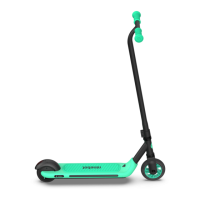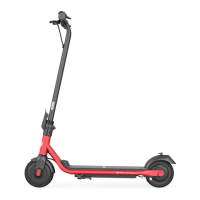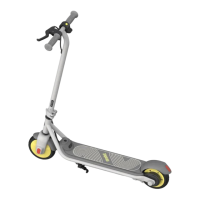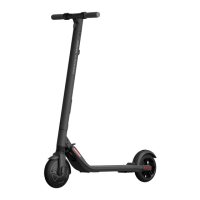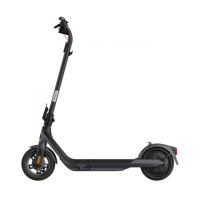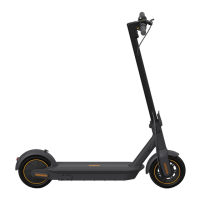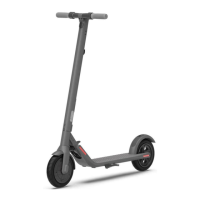16 17
10 Specifications
[1] Typical Range: tested while riding under full power, 165 lbs (75 kg) load, 77°F (25°C) environment temperature, on average speed of 12.4 mph
(20 km/h) on level pavement.
Category Items Parameters
Size
Quality
vehicle
Battery Pack
Display Panel
Motor
Charger
21 × 18 × 7 in (530 × 457 × 178 mm)
330 lbs (150 kg)
Approx. 52.9 lbs (24 kg)
55.9 miles (90 km)
25°
51.8 VDC
14–104°F (-10–40°C)
36–104°F (2–40°C)
-4–122°F (-20–50°C)
58.8 VDC
995 Wh
1800 W
Overvoltage/ Under voltage/Short Circuit/Overheating Protection,
Auto-Sleep/Wake-up, detailed information of battery can be checked with App.
100–240 VAC
58.8 VDC
2 A
120 W
Vehicle Size
Max. Load
Net Weight
Age range
Height
Max. Speed
Typical Range
Max. Slope
Beginner Mode
Traversable Terrains
Operating Temperature
Storage Temperature
Charging Temperature
IP Rating
Duration of Charging
Nominal Voltage
Max Charging Voltage
Nominal Capacity
Battery Management System
Power
Output Power
Input Voltage
Output Voltage
Output Current
Riding
Requirements
16–60 years
4'3"–6'6" (130–200 cm)
Will be automatically disabled after you have traveled 1 km. You can
re-enter beginner mode at any time through the App.
IPX4
Packed dirt, flat pavement, slopes < Maximum Slope, obstacles < 5cm, gaps < 10cm,
standard speed bumps, puddles < 2cm.
Approx. 28 mph (45 km/h)
Automatic optical induction LED lights, rear light/ stoplight, ambient light on wheel hub.
Approx. 10.5 h
[1]
Cleaning and Storage
Use a soft, wet cloth to wipe the mainframe clean. Hard to remove dirt can be scrubbed with a
toothbrush and toothpaste, then cleaned with a soft, wet cloth.
NOTE
Do not wash your Ninebot Z10 with alcohol, gasoline, acetone, or other corrosive/volatile solvents.
These substances may damage the appearance and internal structure of your Ninebot Z10. Do not
wash your Ninebot Z10 with a power washer or hose.
WARNING
Make sure the Ninebot Z10 is powered OFF, the charging cable is unplugged, and the rubber cap on
the charge port is tightly sealed before clean
ing; otherwise you may damage the electronic
components. Store your Ninebot Z10 in a cool, dry place. Do not store it outdoors for extended
periods of time. Exposure to sunlight and extreme temperature (both hot and cold) will accelerate
the aging process of the plastic components and may reduce battery life.
Battery Pack Maintenance
Do not store or charge the battery at temperatures outside the stated limits (see Specifications).
Do not puncture the battery. Refer to your local laws and regulations regarding battery recycling
and/or disposal. A well maintained b
attery can perform well even after many miles of riding. Charge
the battery after each ride and avoid draining the battery completely. When used at room temperature
(70°F [22°C]) the battery range and performance is at its best; whereas using it at temperatures
below 32°F (0°C) can decrease range and performance. Typically, at -4°F (-20°C) range can be half
that of the same battery at 70°F (22°C). Battery range will recover when temperature rises. More
details are available in the App.
NOTE
Typically, a fully charged battery should retain
charge for 120-180 days. A low-power battery should
retain charge for 30-60 days. Remember to charge the battery after each use. Completely draining
the battery may cause permanent damage to the battery. Electronics inside the battery record the
charge-discharge condition of the battery; damage caused by over-charging or under-charging will
not be covered by the Limited Warranty.
WARNING
Do not attempt to disassemble the battery. Risk of fire. No user serviceable parts.
WARNING
Do not ride when the ambient temperature is outside the mach
ine operation temperature (see
Specifications) because low/high temperature will limit the maximum power/torque. Doing so could
cause personal injury or property damage due to slips or falls.
Waste Electrical and Electronic Equipment (WEEE) Directive
"All products bearing this symbol are waste electrical and electronic equipment (WEEE as in directive
2012/19/EU) which should not be mixed with unsorted household waste. Instead, you should protect
human health and the environment by handing over your waste equipment to a designated collection
11 Certification
European Union Compliance Statement
Battery recycling information for the European Union
Batteries or packaging for batteries are labeled in accordance with European Directive 2006/66/EC
concerning batteries and accumulators and waste batteries and accumulators. The Directive
determines the framework for the return and recycling of used batteries and accumulators as applicable
throughout the European Union. This label is applied to various batteries to indicate that the
battery is not to be thrown away, but rather reclaimed upon end of life per the Directive.
In accordance with the European Directive 2006/66/EC, batteries and accumulators are labeled to
Indicate that they are to be collected separately and recycled at end of life. the label on the battery amy
also include a chemical symbol for the metal concerned in the battery (Pb for Lead, Hg for mercury, and
Cd for Cadmium), Users of batteries and accumulators must not dispose of batteries and accumulators
as unsorted municipal waste, but use the collection framework available to customers for the return,
recycling, and treatment of batteries and accumulators. Customer participation is important to minimize
any potential effects of batteries and accumulators on the environment and human health due to the
potential presence of hazardous substances.
Before placing electrical and electronic equipment (EEE) in the waste collection stream or in waste
collection facilities, the end user of equipment containing batteries and/or accumulators must remove
those batteries and accumulators for separate collection.
